The IEEE PRESS Series on Electromagnetic Waves consists of new titles
as well as reprints and revisions of recognized classics that maintain
long-term archival significance in electromagnetic waves and applications.
Donald G. Dudley
Editor
University of Arizona
Advisory Board
Robert E. Collin
Case Western University
Akira Ishimaru
University of Washington
Electromagnetic Theory, Scattering, and Diffraction
Associate Editors
Ehud Heyrnan
Tel-Aviv University
Differential Equation Methods
Andreas C. Cangellaris
University of Arizona
Integral Equation Methods
Donald R. Wilton
University of Houston
Antennas, Propagation, and Microwaves
David R. Jackson
University of Houston
Series Books Published
Collin, R. E., Field Theory of Guided Waves, 2d. rev. ed., 1991
Tai, C. T., Generalized kctor and Dyadic Analysis:
Applied Mathematics in FieM Theory, 1991
Dyadic Green Functions
in Electromagnetic Theory
Second Edition
Chen-To Tai
Professor Emeritus
Radiation Laboratory
Department of Electrical Engineering
and Computer Science
University of Michigan
IEEE PRESS Series on
Electromagnetic Waves
G. Dudley, Series Editor
Elliott, R. S., Electromagnetics: History, Theory, and Applications, 1993
Harrington, R. F., Field Computation by Moment Methoh, 1993
Tai, C. T, Dyadic Green Functions in Electromagnetic Theory, 2nd ed., 1993
Future Series Title
Dudley, D. G., Mathematical Foundations of Electromagnetic Theory
IEEE Antennas and Propagation Society and
IEEE Microwave Theory and Techniques Society, Co-sponsors
The Institute of Electrical and Electronics Engineers, Inc., New York
�
1993 Editorial Board
William Perkins, Editor in Chief
G. F. Hoffnagle
R. F. Hoyt
J. D. Irwin
S. V. Kartalopoulos
P. Laplante
1. Peden
M. Lightner
L. Shaw
E. K. Miller
M. Simaan
J. M. F. Moura D. J. Wells
R. S. Blicq
M. Eden
D. M. Etter
J. J. Farrell I11
L. E. Frenzel
Dudley R. Kay, Director of Book Publishing
Carrie Briggs, Administrative Assistant
Karen G. Miller, production Editor
IEEE Antennas and Propagation Society, Co-sponsor
AP-S Liaison to IEEE PRESS
Robert J. Mailloux
Rome Laboratory, ERI
IEEE Microwave Theory and Techniques Society, Co-sponsor
M'IT-S Liaison to IEEE PRESS
Kris K. Agarwal
E-Systems
Technical Reviewers
Dedicated
to
Professor Chih Kung Jen
(An Inspiring Teacher of Science and Humanity)
Nicolaos G. Alexopoulos Edmund K. Miller
University of California
at Los Angeles
Robert E. Collin
University
Los Alamos National Laboratory Case Western Reserve
Kai Chang
Texas A & M University
01994 by the Institute of Electrical and Electronics Engineers, Inc.
345 East 47th Street, New York, NY 10017-2394
01971 International Textbook Company
All rights reserved. No part of this book may be reproduced in any form,
nor may it be stored in a rem'eval system or transmitted in any form,
without written permission from the publisher.
Printed in the United States of America
1 0 9 8 7 6 5 4 3 2 1
ISBN 0-7803-0449-7
IEEE Order Number: PC0348-3
Library of Congress Cataloging-in-Publication Data
Dyadic green functions in electromagnetic theory
Tai Chen-To (date)
by Chen-to Tai.-2nd
cm.
p.
ed.
Sponsors : IEEE Antennas and Propagation Society and IEEE Microwave
The0 and Techniques Society.
~ n c l u z s Biblio aphical references and index.
ISBN 0-7803-&-7
1. Electroma etic theory-Mathematics.
2. Green's functions.
I. IEEE Antennas and Propagation
3. Boundary v a E problems.
Society. 11. IEEE Microwave Theory and Techniques Society.
Ill. Title
93-24201
CIP
�
Contents
PREFACE
ACKNOWLEDGMENTS
1 GENERAL THEOREMS AND FORMULAS
1-1 Vector Notations and the Coordinate Systems
1-2 Vector Analysis
1-3 Dyadic Analysis
1-4 Fourier Transform and Hankel Transform
1-5 Saddle-Point Method of Integration and Semi-infinite
4
6
12
1
Integrals of the Product of Bessel Functions
16
2 SCALAR GREEN FUNCTIONS
2-1 Scalar Green Functions of a One-Dimensional Wave
Equation-Theory of Transmission Lines
21
2-2 Derivation of go(x, x') by the Conventional Method
and the Ohm-Rayleigh Method
25
2-3 Symmetrical Properties of Green Functions
2-4 Free-Space Green Function of the Three-Dimensional
33
Scalar Wave Equation
35
3 ELECTROMAGNETIC THEORY
3-1 The Independent and Dependent Equations
and the Indefinite and Definite Forms
of Maxwell's Equations
38
3-2 Integral Forms of Maxwell's Equations
3-3 Boundary Conditions
3-4 Monochromatically Oscillating Fields
42
in Free Space
47
3-5 Method of Potentials
49
41
xi
xiii
1
38
vii
�
viii
4 DYADIC GREEN FUNCTIONS
4-1 Maxwell's Equations in Dyadic Form and Dyadic
Green Functions of the Electric and Magnetic Trpe
4-2 Free-Space Dyadic Green Functions
4-3 Classification of Dyadic Green Functions
4-4 Symmetrical Properties of Dyadic Green Functions
4-5 Reciprocity Theorems
4-6 Transmission Line Model of the Complementary
62
85
59
Reciprocity Theorems
90
4-7 Dyadic Green Functions for a Half Space Bounded
by a Plane Conducting Surface
92
5 RECTANGULAR WAVEGUIDES
5-1 Rectangular Vector Wave Functions
5-2 The Method of Em
5-3 The Method of ??,
5-4 The Method of EA
5-5 Parallel Plate Waveguide
5-6 Rectangular Waveguide Filled
103
110
114
115
with Two Dielectrics
5-7 Rectangular Cavity
5-8 The Origin of the Isolated Singular Term in F,
118
124
128
6 CYLINDRICAL WAVEGUIDES
6-1 Cylindrical Wave Functions with Discrete
Eigenvalues
133
6-2 Cylindrical Waveguide
6-3 Cylindrical Cavity
6-4 Coaxial Line
143
142
140
7 CIRCULAR CYLINDER IN FREE SPACE
7-1 Cylindrical Vector Wave Functions with Continuous
Eigenvalues
149
7-2 Eigenfunction Expansion of the Free-Space Dyadic
Green Functions
152
7-3 Conducting Cylinder, Dielectric Cylinder, and Coated
Cylinder
154
7-4 Asymptotic Expression
159
8 PERFECTLY CONDUCTING ELLIPTICAL CYLINDER
8-1 Vector Wave Functions in an Elliptical Cylinder
Coordinate System
161
8-2 The Electric Dyadic Green Function of the First
Kind
166
9 PERFECTLY CONDUCTING WEDGE AND THE HALF SHEET
9-1 Dyadic Green Functions for a Perfectly
Conducting Wedge
169
9-2 The Half Sheet
173
Contents
Contents
55
55
74
9-3 Radiation from Electric Dipoles in the Presence
174
of a Half Sheet
9-3.1 Longitudinal Electrical Dipole
9-3.2 Horizontal Electrical Dipole
9-3.3 Vertical ~lectric Dopole
178
174
176
9-4 Radiation from Magnetic Dipoles in the Presence
of a Half Sheet
179
9-5 Slots Cut in a Half Sheet
9-5.1 Longititudinal Slot
9-5.2 Horizontal Slot
184
182
183
96
9-6 Diffraction of a Plane Wave by a Half Sheet
9-7 Circular Cylinder and Half Sheet
196
187
10 SPHERES AND PERFECTLY CONDUCTING CONES
10-1 Eigenfunction Expansion of Free-Space Dyadic
10-2 An Algebraic Method of Finding E,, without the
Green Functions
198
Singular Term
204
10-3 Perfectly Conducting and Dielectric Spheres
10-4 Spherical Cavity
10-5 Perfectly Conducting Conical Structures
10-6 Cone with a Spherical Sector
218
223
220
210
1 1 PLANAR STRATIFIED MEDIA
11-1 Flat Earth
11-2 Radition from Electric Dipoles in the Presence
225
of a Flat Earth and Sommerfeld's Theory
228
11-3 Dielectric Layer on a Conducting Plane
11-4 Reciprocity Theorems for Stratified Media
11-5 Eigenfunction Expansions
11-6 A Dielectric Slab in Air
11-7 Two-Dimensional Fourier Transform of the Dyadic
244
249
233
237
Green Functions
251
12
169
INHOMOGENEOUS MEDIA AND MOVING MEDIUM
12-1 Vector Wave Functions for Plane
255
12-2 Vector Wave Functions for Spherically
Stratified Media
Stratified Media
255
259
12-3 Inhomogeneous Spherical Lenses
12-4 Monochromatically Oscillating Fields in a Moving
260
Isotropic Medium
270
12-5 Time-Dependent Field in a Moving Medium
12-6 Rectangular Waveguide with a Moving Medium
12-7 Cylindrical Waveguide with a Moving Medium
12-8 Infinite Conducting Cylinder
293
in a Moving Medium
277
286
291
�
APPENDIX A MATHEMATICAL FORMULAS
A-1 Gradient, Divergence, and Curl
296
in Orthogonal Systems
A-2 Vector Identities
A-3 Dyadic Identities
A-4 Integral Theorems
APPENDIX B VECTOR WAVE FUNCTIONS
298
298
299
A N D THEIR MUTUAL RELATIONS
B-1 Rectangular Vector Wave Functions
B-2 Cylindrical Vector Wave Functions with Discrete
302
Eigenvalues
304
B-3 Spherical Vector Wave Functions
B-4 Conical Vector Wave Functions
APPENDIX C EXERCISES
305
306
REFERENCES
NAME INDEX
SUBJECT INDEX
Contents
296
Preface
The first edition of this book, bearing the same title, was published by Intext Edu-
cation Publishers in 1971. Since then, several topics in the book have been found
to have been improperly treated; in particular, a singular term in the eigenfunc-
tion expansion of the electrical dyadic Green function was inadvertently omitted,
an oversight that was later amended [Tai, 19731.
In the present edition, some major revisions have been made. First,
Maxwell's equations have been cast in a dyadic form to facilitate the introduction
of the electric and the magnetic dyadic Green functions. The magnetic dyadic
Green function was not introduced in the first edition, but it was found to be
a very important entity in the entire theory of dyadic Green functions. Being a
solenoidal function, its eigenfunction expansion does not require the use of non-
solenoidal vector wave functions or Hansen's L-functions [Stratton, 19411. With
the aid of Maxwell-Ampkre equation in dyadic form, one can find the eigenfunc-
tion expansion of the electrical dyadic Green function, including the previously
missing singular term. This method is used extensively in the present edition.
Several other new features are found in this edition. For example, the inte-
gral solutions of Maxwell's equations are now derived with the aid of the vector-
dyadic Green's theorem instead of by the vector Green's theorem as in the old
treatment. By doing so, many intermediate steps can be omitted. In reviewing
Maxwell's theory we have emphasized the necessity of adopting one of two alter-
native postulates in stating the boundary conditions. The implication is that the
boundary conditions cannot be derived from Maxwell's differential equations
without a postulate. Reciprocity theorems in electromagnetic theory are dis-
cussed in detail. In addition to the classical theorems due to Rayleigh, Carson,
and Helmholtz, two complementary reciprocity theorems have been formulated
�
xii
Preface
to uncover the symmetrical relations of the magnetic dyadic Green functions not
derivable from the Rayleigh-Carson theorem.
Various dyadic Green functions for problems involving plain layered media
have been derived, including a two-dimensional Fourier-integral representation
of these functions. In the area of moving media, the problem of transient radi-
ation is formulated with the aid of an affine transformation which enables us to
solve the Maxwell-Minkowski equation in a relatively simple manner.
Many new exercises have been added to this edition to help the reader bet-
ter understand the materials covered in the book. Answers for some exercises
are given, and sufficient hints are provided for many others so that the book
may be used not only as a reference but also as a text for a graduate course in
electromagnetic theory.
Acknowledgments
I am very grateful to Professor Per-Olof Brundell of the University of Lund,
Sweden, who, in 1972, called my attention to the incompleteness of the eigen-
function expansion of the electric dyadic Green function in the original edition
of this book. My discussion with Dr. Olov Einarsson, then a faculty member
of the same institution, on the dependence of the integral of the electric dyadic
Green function on the shape of the cell in the source region was very valuable,
particularly, on the aspect ratio of a cylindrical cell. The works of Prof. Robert
E. Collin consolidate our understanding of the singularity behavior of the dyadic
Green functions. His many communications with me on this subject were very
valuable prior to the publication of a book in this field by Prof. J. Van Blade1
[1991]. I am also very grateful to Prof. Donald G. Dudley and Dr. William A.
Johnson for their very careful review of my original manuscript. Section 5-8 of
Chapter 5 was written as a result of their thoughtful comments.
During the preparation of this manuscript I received the most valuable help
from Ms. Bonnie Kidd. Her expertise in typing this manuscript was invaluable.
The assistance of Dr. Leland Pierce and Ms. Patricia Wolfe are also very much
appreciated.
I would also like to express my sincere thanks to Prof. Fawwaz T. Ulaby,
Director of the Radiation Laboratory at the University of Michigan, for his con-
stant encouragement by providing me with the technical support necessary to
complete this manuscript. Mr. Dudley Kay, Director of Book Publishing, and
Ms. Karen Miller, Production Editor of IEEE Press, have proved to be most
efficient and helpful during all stages of the production of this book.
Chen-To Tai
Ann Arbor, Michigan
xiii
�
Dyadic Green Functions
in Electromagnetic Theory
�
General Theorems
and Formulas
In this chapter we review some of the important theorems and formulas
needed in the subsequent chapters. It is assumed that the reader has had an
adequate course in advanced calculus, including vector analysis, Fourier series
and integrals, and the theory of complex variables. Our review will contain suf-
ficient material so that references to other books will be kept to a minimum. We
sacrifice to some extent the mathematic rigor that may be required in a more
thorough treatment. For example, we use quite freely the integral representa-
tion of the delta function, assuming that an exponential function with imaginary
argument is Fourier transformable. Whenever necessary, adequate references1
will be given to strengthen any plausible statement or to remove possible
ambiguity.
1-1 VECTOR NOTATIONS AND THE COORDINATE
SYSTEMS
A vector quantity or a vector function will be denoted by F. A letter with a hat,
such as P, is used to denote a unit vector in the direction of the covered letter.
In most cases, these letters correspond to the variables
- - in a coordinate system.
The - scalar product of two vectors is denoted by A . B and the vector product by
A x B. The three commonly used systems in this book are
1. Rectangular, or Cartesian, x, y, z
2. Circular cylindrical or simply cylindrical, r, 4, z
3. Spherical, R, 0, 4
'1n the citations in the text, the author's name is used as the identification. If it is a book,
either the section number or the pages will be cited, if necessary.
�

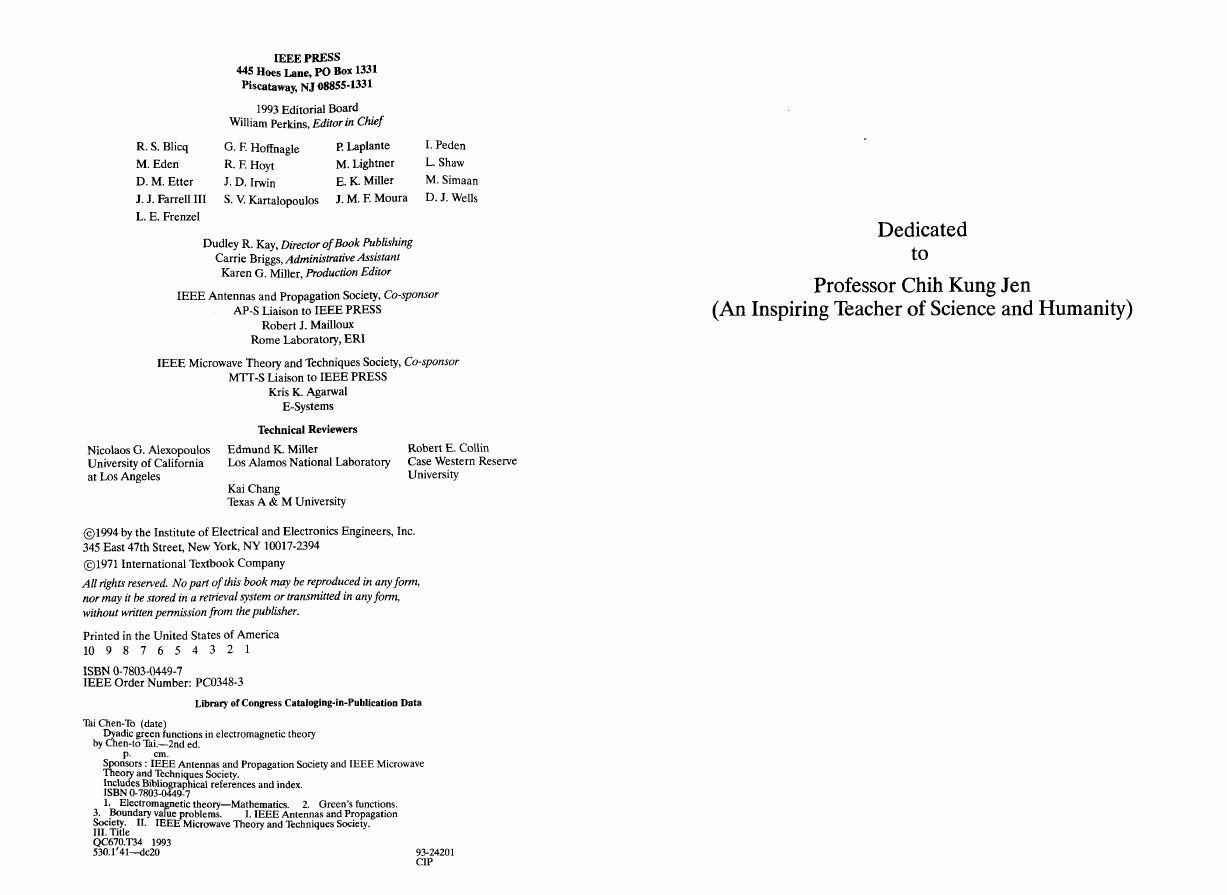
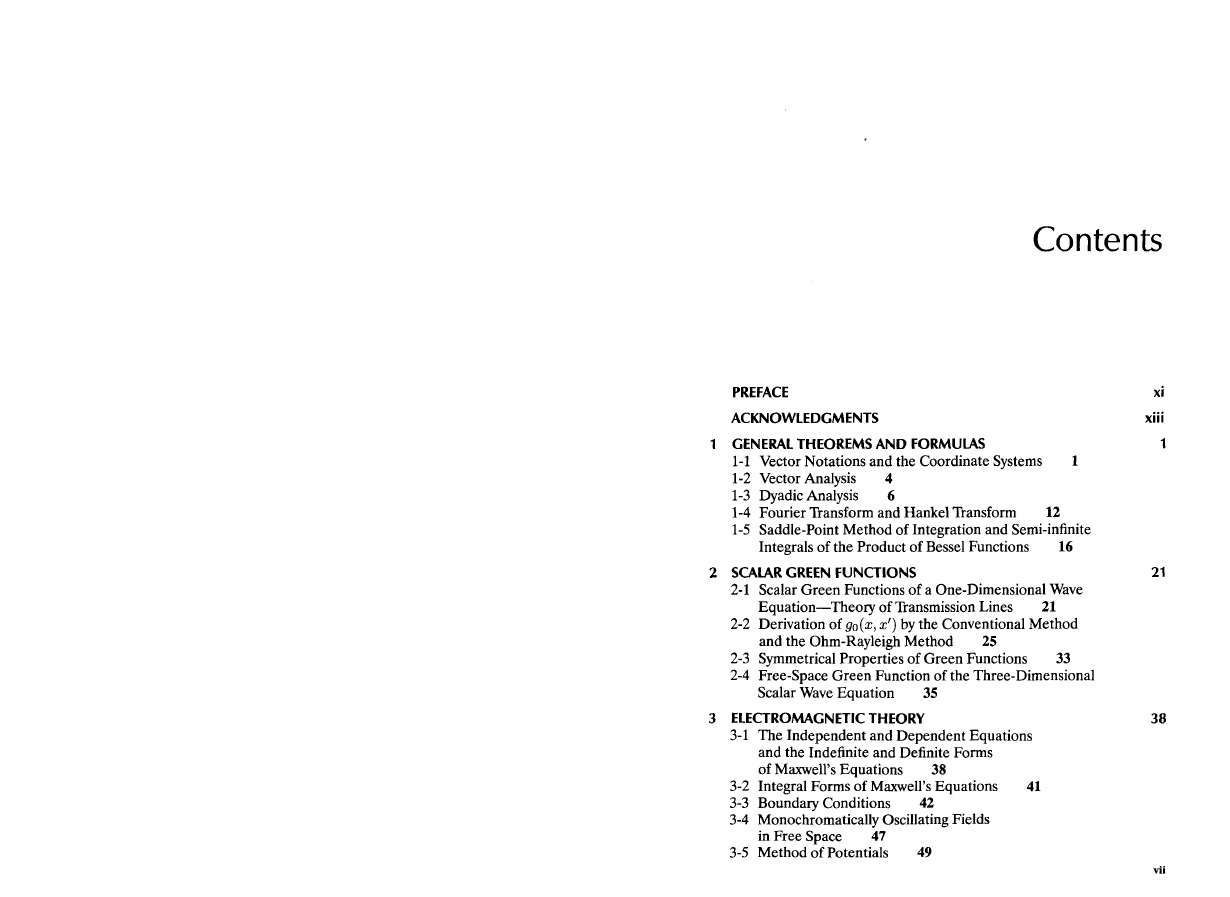
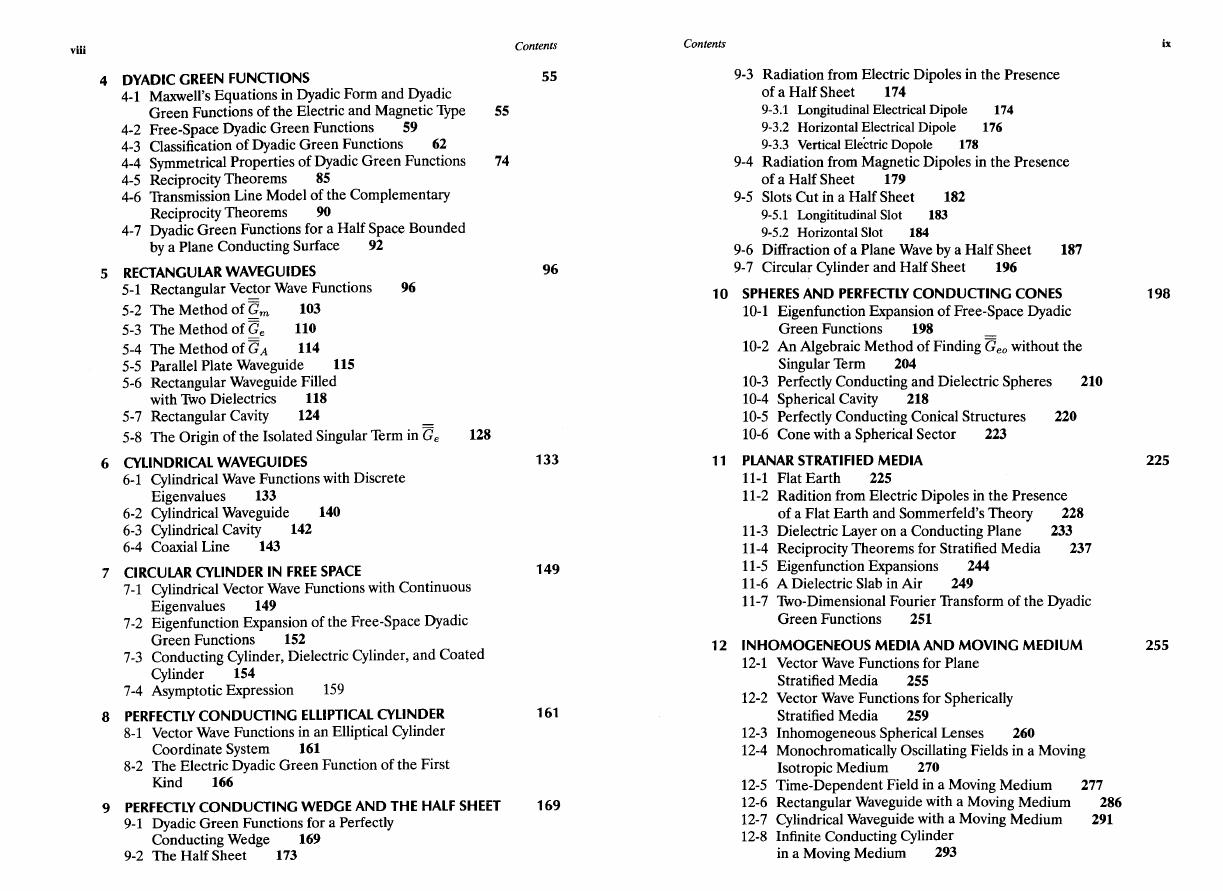
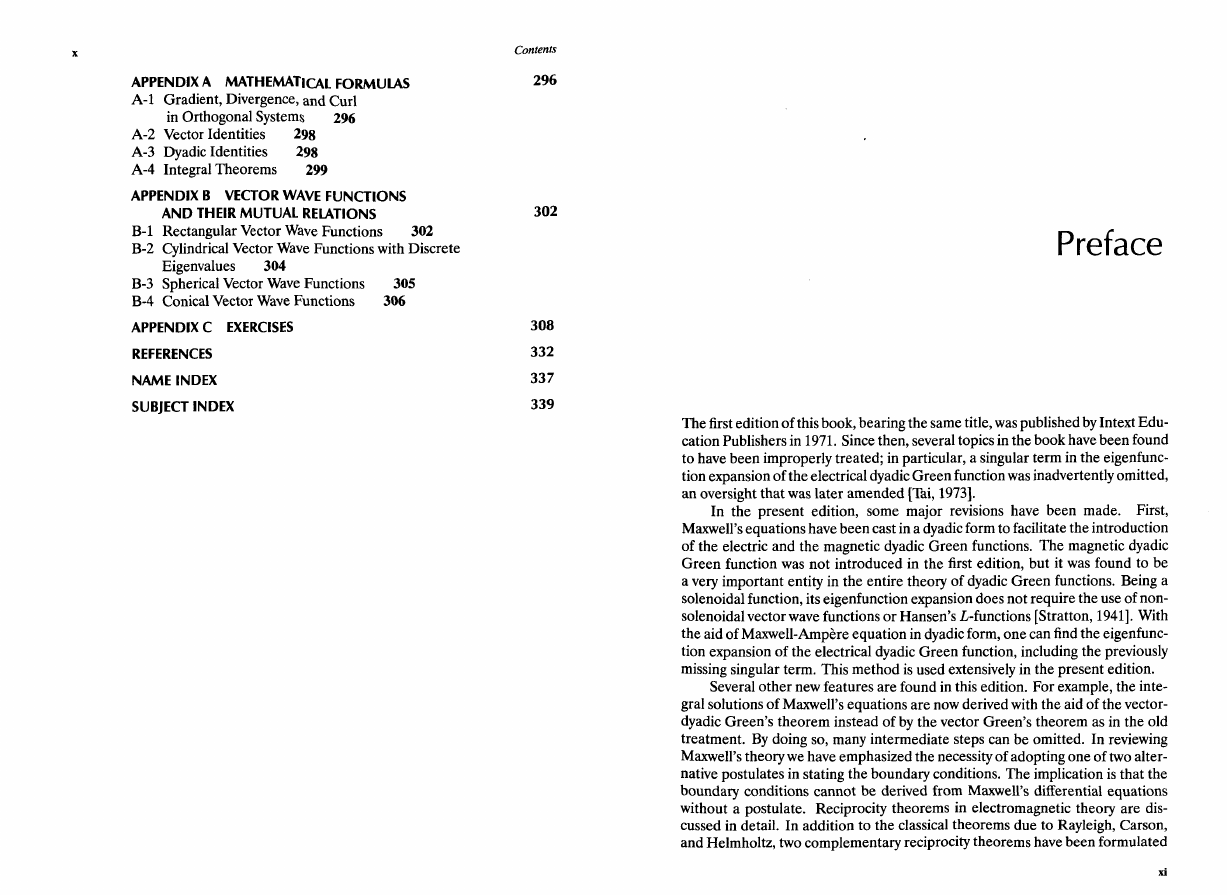

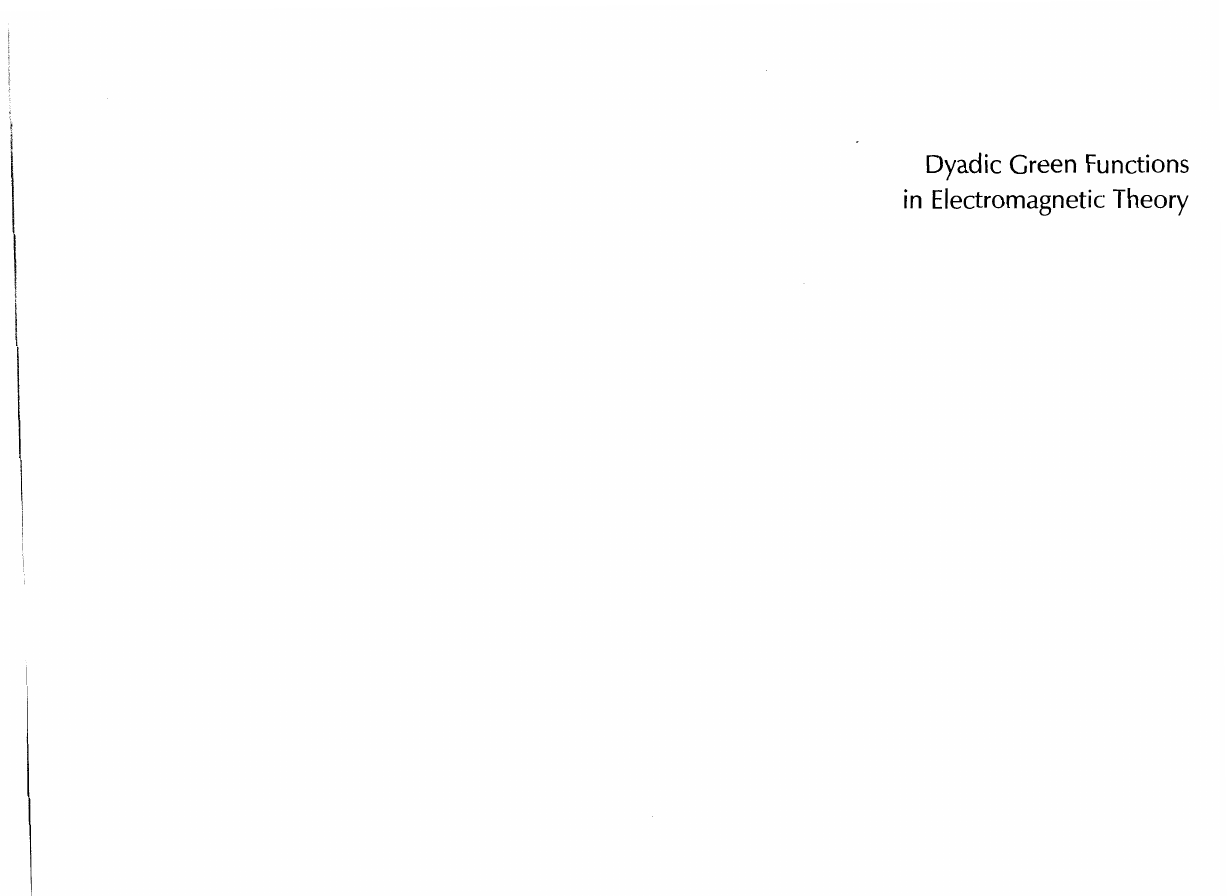
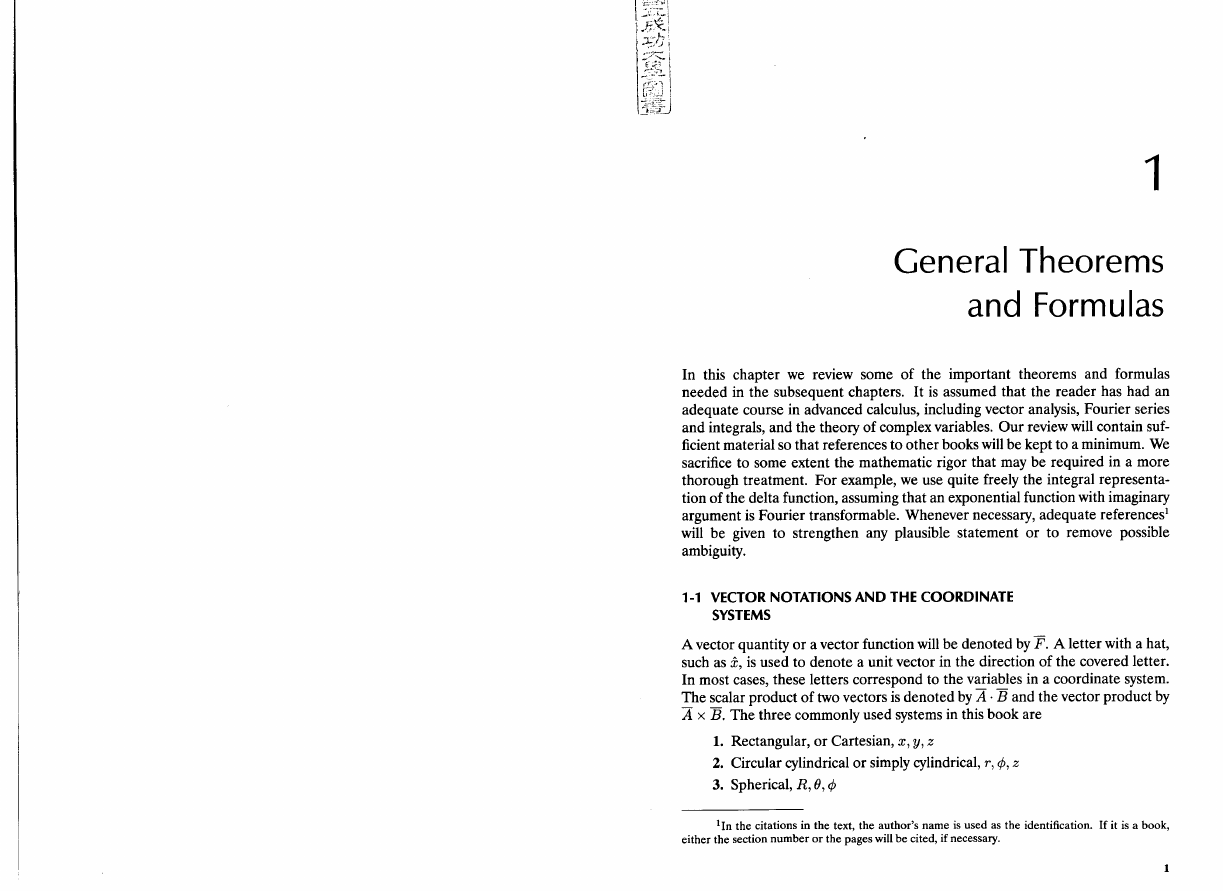








 2023年江西萍乡中考道德与法治真题及答案.doc
2023年江西萍乡中考道德与法治真题及答案.doc 2012年重庆南川中考生物真题及答案.doc
2012年重庆南川中考生物真题及答案.doc 2013年江西师范大学地理学综合及文艺理论基础考研真题.doc
2013年江西师范大学地理学综合及文艺理论基础考研真题.doc 2020年四川甘孜小升初语文真题及答案I卷.doc
2020年四川甘孜小升初语文真题及答案I卷.doc 2020年注册岩土工程师专业基础考试真题及答案.doc
2020年注册岩土工程师专业基础考试真题及答案.doc 2023-2024学年福建省厦门市九年级上学期数学月考试题及答案.doc
2023-2024学年福建省厦门市九年级上学期数学月考试题及答案.doc 2021-2022学年辽宁省沈阳市大东区九年级上学期语文期末试题及答案.doc
2021-2022学年辽宁省沈阳市大东区九年级上学期语文期末试题及答案.doc 2022-2023学年北京东城区初三第一学期物理期末试卷及答案.doc
2022-2023学年北京东城区初三第一学期物理期末试卷及答案.doc 2018上半年江西教师资格初中地理学科知识与教学能力真题及答案.doc
2018上半年江西教师资格初中地理学科知识与教学能力真题及答案.doc 2012年河北国家公务员申论考试真题及答案-省级.doc
2012年河北国家公务员申论考试真题及答案-省级.doc 2020-2021学年江苏省扬州市江都区邵樊片九年级上学期数学第一次质量检测试题及答案.doc
2020-2021学年江苏省扬州市江都区邵樊片九年级上学期数学第一次质量检测试题及答案.doc 2022下半年黑龙江教师资格证中学综合素质真题及答案.doc
2022下半年黑龙江教师资格证中学综合素质真题及答案.doc